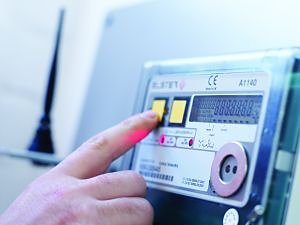|
|
Continue reading ETI Views and News at
econtech.com,
or download a
printer-friendly version.

Follow us on Twitter @EconAndTech
|
|
As SmartMeter deployment expands, consumer skepticism and community opposition escalate
|
|
 For some time now, energy policymakers and electric utilities have promoted the concept of a "smart grid" as an important energy conservation measure. The smart grid consists of two principal components – "SmartMeters" deployed at every customers' home and business premises, and a telecommunications network of some sort to interconnect those devices with the utility and in so doing maintain bi-directional contact on a real-time basis.
For some time now, energy policymakers and electric utilities have promoted the concept of a "smart grid" as an important energy conservation measure. The smart grid consists of two principal components – "SmartMeters" deployed at every customers' home and business premises, and a telecommunications network of some sort to interconnect those devices with the utility and in so doing maintain bi-directional contact on a real-time basis.
How SmartMeters work
At the customer's end, the SmartMeter sends data to and receives data from appliances within the customer's home using any of several technologies – e.g., a data communications protocol known as Power Line Carrier (PLC), or a variant on an in-home Wi-Fi network. Individual appliances are plugged into special adapters that are plugged into standard wall outlets. The SmartMeter can then establish communication with each adapter and control the status of each connected appliance, based upon customer-specified priorities and other customer-programmed parameters based on such things as then-current pricing, time-of-day, and the like.
The SmartMeter continuously monitors the customer's electricity use and transmits that data in real time directly to the power company, which aggregates the demand data across its entire customer base and adjusts its price in real time in response to increases or decreases in demand. These price adjustments are then communicated back to the customer's SmartMeter and, via the customer's in-home data network, to individual electrical appliances that can be programmed to turn off when the per-kwh price rises above a preestablished threshold and turn back on when the price drops back below that level. For example, the customer might program some air conditioners to power down whenever the price goes above $0.25 per kwh, while programming others to stay in operation until the price reaches $0.35. Other appliances that cannot tolerate power interruptions, such as refrigerators, might have no shut-off threshold, while those whose use could be shifted to off-peak times, such as clothes dryers, might be set to shut off at the $0.15 level. SmartMeters can provide a means whereby electric cars can be recharged during late-night time periods when demand for electricity – and the associated price level – is lowest.
But is it really necessary for electric utilities to construct a special high-capacity two-way telecommunications networks in order to provide these capabilities?
Do SmartMeters really need to maintain real-time bi-directional communication with the electric utility?
While SmartMeters have the ability to engage in ongoing real time communication, in both directions, with the power company, it is far from clear that any such bi-directionality is actually necessary for a SmartMeter to support real time price-driven demand responses. For one thing, the utility does not need to collect and aggregate usage data in real time from each of its individual customers' meters to know how much electricity is being supplied over its distribution network at any given moment – it just needs to look at the load meters at its power stations. As for communicating real time pricing information to its customers' SmartMeters, the utility could employ any of several low-cost unidirectional communications strategies; for example, it could simply broadcast this data over an FM sideband channel obtained from a local FM radio station to inexpensive FM radio data receivers built into the meters themselves.
While SmartMeters are typically promoted as an effective "demand-side" conservation measure critical to national energy policy, the real motivation for deployment of SmartMeters capable of bi-directional communication with the utility is likely driven mainly – or solely – by certain operational benefits that the utility obtains that have little to do with conservation – benefits that by themselves could not justify the massive expenditures required to constructe a smart grid. These benefits include eliminating manual meter reading, implementing remote service connects and disconnects, and improved outage responses.
Yet it is this claimed need for bi-directional real time telemetry that has driven the second smart grid component – the telecommunications network linking individual meters with the utility's network control facility. Unlike the type of data typically carried over consumer broadband Internet access services – such as the multi-megabit per second data rates required for video streaming and other video applications – the volume of data being sent between an individual SmartMeter and the electric utility is minuscule by comparison – somewhere in the range of a few hundred bits per second. So even if bi-directionality is actually needed – and it probably isn't – such low-speed data transmission requirements are well within the capacity and capability of existing telecommunications services already in place in most American homes – standard telephone service, and high-speed Internet access. Yet despite the availability of an existing telecommunications infrastructure fully capable of meeting the data transmission needs of a smart grid, electric utilities have almost universally pursued a "build our own" strategy for establishing communications with their customers. And therein lies much of the controversy.
Does a "smart grid" need its own telecom infrastructure?
Several types of smart grid telecom networks are being pursued. In a few cases, utilities are constructing fiber optic links to each of their customers. Power Line Carrier over the utility's own power lines is also being used. One particularly popular approach, however, is the so-called "RF (radio frequency) mesh." In a "mesh network," individual SmartMeters deployed at each customer's home or business location establish bi-directional communication links with one or more nearby SmartMeters, creating a daisy chain of these devices that successively hand-off the transmitted data to, and receive transmitted data from, the next SmartMeter down the line. Because each individual SmartMeter has a relatively short transmission distance range, the success of a mesh network depends critically upon the deployment of a large number of individual meters in relatively close geographic proximity to one another.
As the installation of SmartMeters has proceeded, some consumers and communities have expressed concerns regarding the use of RF transmission and mesh networks. Several California counties have gone so far as to enact local ordinances calling for a moratorium on SmartMeter deployment due to concerns regarding the health effects arising from the electromagnetic frequency (EMF) radiation associated with such transmissions. They have also expressed the concern that SmartMeter transmissions may be intercepted by unauthorized persons, threatening individual privacy and safety, and that these transmissions may interfere with amateur radio and public safety communications. Several state utility commissions (Maryland, Hawaii) have denied permission for SmartMeter deployment, and several others (California, Maine) have proceedings underway to consider how "opt-out" requests by individuals and entire communities may be accommodated. The utilities have claimed that such "opt-outs" engender significant additional costs, and have proposed fairly steep initial and recurring charges to be paid by customers electing this option. The sheer magnitude of the proposed fees have raised concerns that their real purpose is as a deterrent, not cost recovery.
Accepting, for purposes of discussion, the merits of SmartMeters capable of bi-directional communication as a valid and economically justified energy conservation measure, it is far less clear as to why the telecommunications requirements of a smart grid could not be fully – and far more efficiently – satisfied using existing telecom network infrastructure rather than the type of greenfield deployments being pursued by the electric utilities. But there may well be some rational business explanation for the electric utilities' adoption of this approach.
Averch and Johnson are alive and well
A seminal 1962 paper published in the American Economic Review, "Behavior of the Firm Under Regulatory Constraint" by Harvey Averch and Leland Johnson, posited that rate-of-return type regulation creates an incentive for the firm to over-invest in tangible assets. Since the "allowed profit" is based upon the rate base, the firm has an incentive to augment – to "gold plate" – its capital stock. The resulting discourse spawned by Averch and Johnson led ultimately to the phase-out of rate-of-return regulation of most telecom utilities. However, the majority of local electric distribution utilities (LDCs) are still regulated in this manner, which means that their smart grid investments become part of their rate base upon which they are entitled to earn a return. Additionally, federal stimulus money and other explicit government subsidies have been provided to encourage such investment – for example, in 2009, electric utilities across the country received some $3.4-billion in funding under the US Department of Energy's Smart Grid Investment Grant program. Between rate-of-return regulation's assurance of what are by today's standards rather attractive returns and virtually guaranteed investment recovery, together with outright government grant money, the power companies and their shareholders were and are never "at risk" with respect to SmartMeter and smart grid investments. So who is "at risk"? Customers. Whether or not these investments ultimately prove their worth, utility customers will ultimately bear the cost either as ratepayers or as taxpayers.
Moreover, these smart grid networks readily satisfy Averch-Johnson's "gold plating" expectation. The transmission capacities of the networks being constructed far exceed the minimal data rates that are involved in the short-burst telemetry transmissions required for SmartMeter communication. Once in place, the electric utility's telecom infrastructure could be readily adapted to support broadband, wireless backhaul, and other services currently offered by cable television companies and local telecommunications carriers. And while some additional capital outlays may be required to adapt the utility's infrastructure to support these additional services, the core infrastructure will have been underwritten by electricity customers and by government grants. A pretty good deal.
What happens next?
Smart grid initiatives have been under discussion in utility and regulatory circles for a number of years, but for the general public they have remained largely opaque until the electric utility technician shows up at the consumer's front door with a SmartMeter in hand. As consumer awareness about these initiatives grows, the extent to which smart grid programs generate widespread public acceptance remains to be seen.
If you would like more information on this subject, please contact Dr. Lee L. Selwyn.
Read the rest of Views and News, April 2011.
|
|
|
|
About ETI. Founded in 1972, Economics and Technology, Inc. is a leading research and consulting firm specializing in telecommunications regulation and policy, litigation support, taxation, service procurement, and negotiation. ETI serves a wide range of telecom industry stakeholders in the US and abroad, including telecommunications carriers, attorneys and their clients, consumer advocates, state and local governments, regulatory agencies, and large corporate, institutional and government purchasers of telecom services. |
|
|